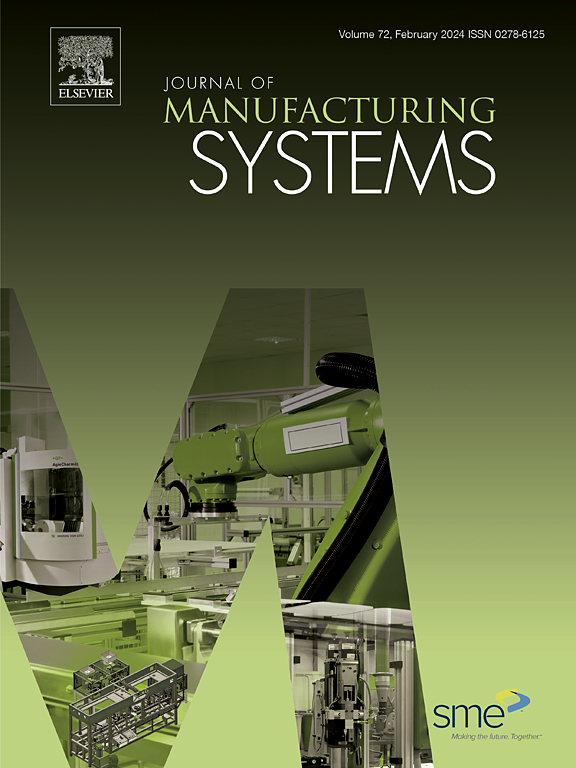多阶段制造系统质量传播的机器节点增强图对比学习与远程提示模型
IF 14.2
1区 工程技术
Q1 ENGINEERING, INDUSTRIAL
引用次数: 0
摘要
更复杂的多阶段制造系统(mms)已经成为主流的生产工艺。深度学习可以准确预测产品质量指标,帮助提高产品合格率。现有的单阶段模型只能预测单机或单阶段的质量,忽略了传播效应。尽管一些多阶段模型考虑了质量传播效应,但它们只是在一个阶段内汇总了机器的特征。此外,现有的多阶段模型在利用机床空间关系时不符合实际生产过程。传统模型对标签数据依赖严重,难以充分利用噪声数据,导致预测精度降低,缺乏可解释性。针对上述问题,本文提出了一种具有远程提示的机器节点增强图对比学习方法(MNGCLP),在预训练和微调中同时提取传播效应。具体而言,首先使用图形数据对机器之间的生产关系进行建模,形成生产过程图。然后,在基于对比的预训练中设计机器增强图,更好地添加生产信息,避免违反生产过程,减少标签依赖。最后,利用原始图中捕获的机器节点之间的距离关系作为提示对预训练模型进行微调。公共生产数据实验表明,该方法优于传统模型,为预测结果提供了合理的解释,验证了MNGCLP的有效性。与监督图神经网络相比,该模型的总体RMSE、MSE和MAE分别提高了2.4 %、4.8 %和9.8 %。与对比图神经网络相比,该模型的总体RMSE、MSE和MAE分别提高了2.5 %、5.0 %和6.3 %。本文章由计算机程序翻译,如有差异,请以英文原文为准。
Machine node-enhanced graph contrastive learning with long-range prompt model for quality propagation in multistage manufacturing systems
More complex multistage manufacturing systems (MMSs) have become mainstream production processes. Deep learning can accurately predict product quality indicators and help improve product qualification rates. Existing single-stage models can only predict the quality of a single machine or a single stage, ignoring the propagation effects. Although some multistage models consider quality propagation effects, they simply aggregate the machine features within a stage. In addition, existing multistage models do not conform to the actual production process when utilizing machine space relationships. Traditional models with severe label data dependence are difficult to make full use of noise data, resulting in reduced prediction accuracy and lack of interpretability. To address the above problems, this paper proposes a machine node-enhanced graph contrastive learning method with long-range prompt (MNGCLP), extracting propagation effects in both pre-training and fine-tuning. Specifically, the graph data is first used to model the production relationship between machines and form a production process graph. Then, a machine-enhanced graph is designed in contrastive-based pre-training to better add production information to avoid violating the production process and reduce label dependency. Finally, the long-distance relationship between machine nodes captured in the original graph is used as prompts to fine-tune the pre-trained model. Experiments in public production data show that the proposed method outperforms traditional models and provides a reasonable explanation for the prediction results, validating the effectiveness of MNGCLP. Compared with supervised graph neural network, the proposed model improves the overall RMSE, MSE and MAE by 2.4 %, 4.8 % and 9.8 %, respectively. Compared with the contrastive graph neural network, the proposed model improves the overall RMSE, MSE and MAE by 2.5 %, 5.0 %, and 6.3 %, respectively.
求助全文
通过发布文献求助,成功后即可免费获取论文全文。
去求助
来源期刊

Journal of Manufacturing Systems
工程技术-工程:工业
CiteScore
23.30
自引率
13.20%
发文量
216
审稿时长
25 days
期刊介绍:
The Journal of Manufacturing Systems is dedicated to showcasing cutting-edge fundamental and applied research in manufacturing at the systems level. Encompassing products, equipment, people, information, control, and support functions, manufacturing systems play a pivotal role in the economical and competitive development, production, delivery, and total lifecycle of products, meeting market and societal needs.
With a commitment to publishing archival scholarly literature, the journal strives to advance the state of the art in manufacturing systems and foster innovation in crafting efficient, robust, and sustainable manufacturing systems. The focus extends from equipment-level considerations to the broader scope of the extended enterprise. The Journal welcomes research addressing challenges across various scales, including nano, micro, and macro-scale manufacturing, and spanning diverse sectors such as aerospace, automotive, energy, and medical device manufacturing.
 求助内容:
求助内容: 应助结果提醒方式:
应助结果提醒方式:


